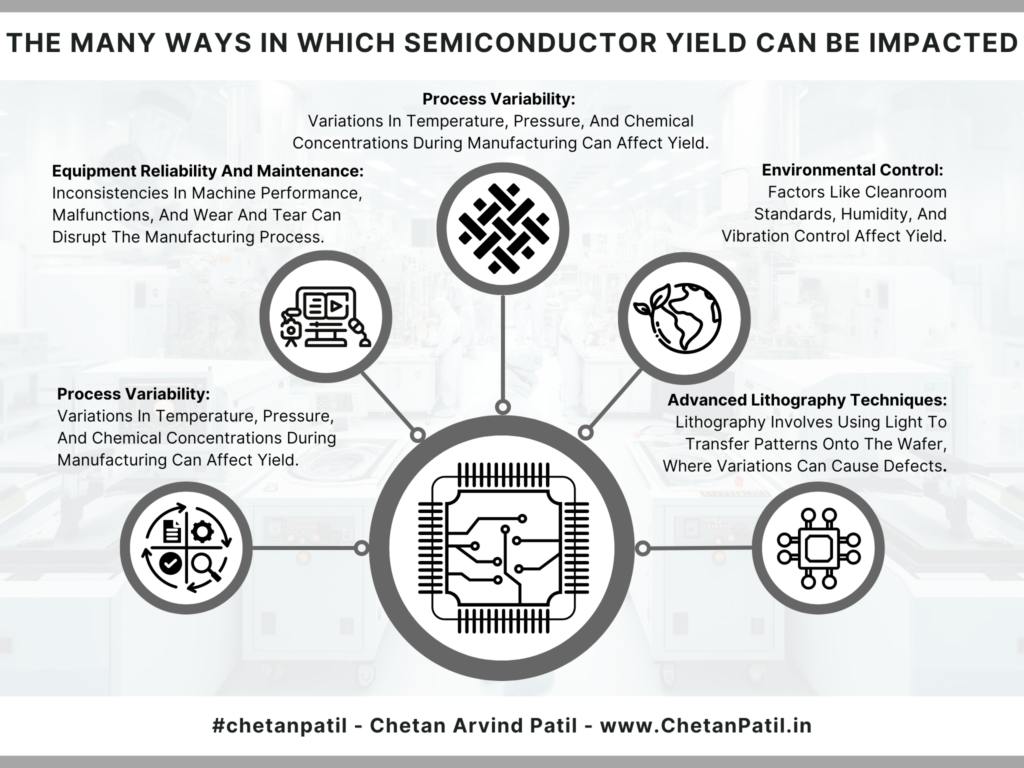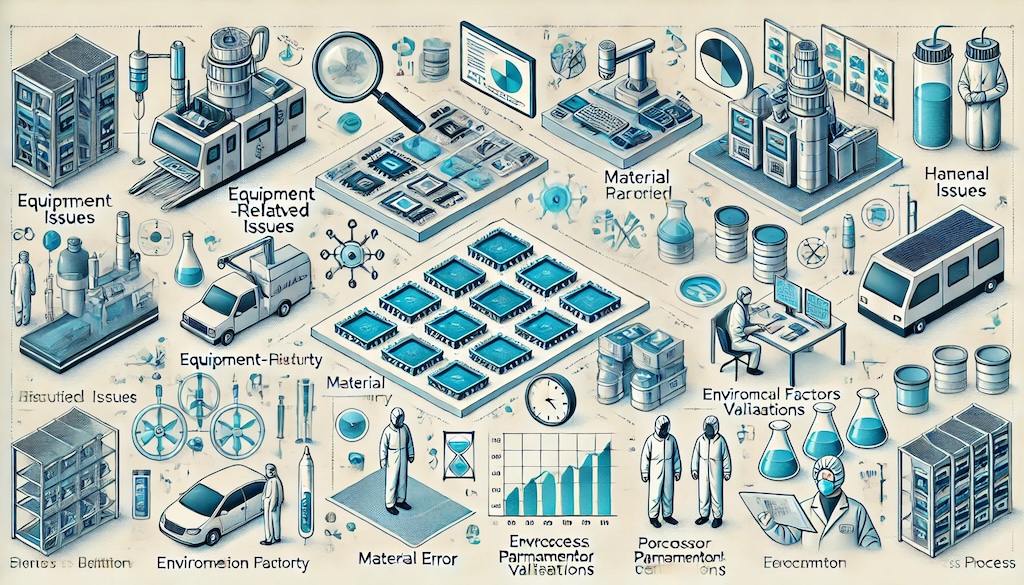Image Generated Using DALL-E
Yield, Cost Efficiency And Product Quality
Understanding the various types of semiconductor yield is essential for optimizing production processes, leading to significant cost savings. Higher yield rates result in more functional chips per wafer, reducing the cost per chip and ensuring efficient use of materials and resources. Manufacturers can minimize waste by identifying and addressing yield-impacting factors, further lowering production costs. This optimization enhances profitability and ensures that the manufacturing process remains sustainable and resource-efficient.
Yield knowledge also directly correlates with the quality and reliability of semiconductor products. High yield rates ensure that the manufacturing process consistently produces high-quality chips, leading to reliable performance in end-user products. By understanding and mitigating defects, manufacturers can improve their semiconductor devices’ overall quality and reliability. This consistency is crucial for maintaining semiconductor manufacturers’ reputations and meeting the stringent quality requirements of various applications, from consumer electronics to critical infrastructure.
Yield For Competitive Advantage And Technological Advancement
Achieving high yield rates is more than just a competitive edge. It is a necessity in the semiconductor market. Companies with optimized yield processes can produce more chips at a lower cost, ensuring they can meet market demand and offer competitive pricing. This advantage is vital in an industry characterized by rapid technological advancements and intense competition. Additionally, leading in yield optimization positions a company as an industry innovator, attracting more business opportunities and potential partnerships, giving you the confidence to compete in this dynamic market.
A deep understanding of yield types drives continuous improvement in manufacturing processes and the adoption of new technologies. This knowledge is essential for staying ahead in the rapidly evolving semiconductor industry. Manufacturers are encouraged to implement advanced techniques such as Extreme Ultraviolet (EUV) lithography, AI-driven defect detection, and machine learning algorithms by focusing on yield optimization. These advancements improve yield rates and enhance the overall efficiency and capability of semiconductor manufacturing.
Optimizing semiconductor yield also contributes to better resource management and sustainability. Efficient use of raw materials reduces the need for excessive resources, minimizing environmental impact. Higher yield rates lead to more energy-efficient manufacturing processes crucial for cost savings and ecological sustainability. This approach aligns with global efforts to reduce carbon footprints and promote sustainable industrial practices.

Semiconductor Yield Category And Impact
In the semiconductor manufacturing industry, yield is a critical metric that measures the efficiency and effectiveness of production processes. Yield refers to the proportion of functional chips produced from a semiconductor wafer. Understanding the various categories and factors that impact semiconductor yield is essential for optimizing production, reducing costs, and maintaining high product quality. This section will explore critical factors influencing semiconductor yield, ranging from defect density and process variability to advanced technological practices and future trends.
| Category and Impact Factor | Description |
|---|---|
| Defect Density and Control | Defect density refers to the number of defects per unit area on a wafer, which can cause chips to be unusable. |
| Process Variability | Variations in temperature, pressure, and chemical concentrations during manufacturing can affect yield. |
| Equipment Reliability and Maintenance | Inconsistencies in machine performance, malfunctions, and wear and tear can disrupt the manufacturing process. |
| Material Quality and Purity | Variations in the quality and purity of raw materials, such as silicon wafers, can introduce defects. |
| Human Factors and Training | Human errors and differences in operator skills can impact yield. |
| Environmental Control | Environmental factors like cleanroom standards, humidity, and vibration control affect yield. |
| Design for Manufacturability (DFM) | DFM ensures products are designed with the manufacturing process in mind to enhance yield. |
| Advanced Lithography Techniques | Lithography involves using light to transfer patterns onto the wafer, where variations can cause defects. |
| Statistical Process Control (SPC) | SPC tools help monitor and control process variations to improve yield. |
| Yield Management Software and Analytics | Advanced software and data analytics are used to identify and address yield issues. |
| Future Trends in Yield Enhancement | Emerging trends such as AI, machine learning, and new materials promise future yield improvements. |
Understanding the numerous factors that impact semiconductor yield is vital for any organization aiming to excel in the semiconductor industry. Manufacturers can significantly enhance yield rates by addressing issues such as defect density, process variability, equipment reliability, and material quality. Additionally, embracing advanced technologies and innovative practices will pave the way for future improvements in yield. By focusing on these critical areas, companies can achieve higher efficiency, reduced costs, and superior product quality, ultimately maintaining a competitive edge in the rapidly evolving semiconductor market.
How Will AI Impact Yield Detection And Improvement
As I conclude this exploration of the factors impacting semiconductor yield, one must highlight the transformative role of Artificial Intelligence (AI) in yield detection and improvement. AI is poised to revolutionize semiconductor manufacturing, providing advanced capabilities to enhance yield rates significantly.
Enhanced Defect Detection: AI-driven systems are highly efficient in identifying defects, surpassing traditional methods in accuracy and speed. Machine learning algorithms can sift through vast amounts of data from production processes to spot patterns and anomalies that may indicate defects. This real-time analysis enables immediate corrective actions, thereby reducing the number of defective chips and enhancing overall yield, providing a sense of reassurance about the quality of the products.
Predictive Maintenance: AI’s predictive capabilities can foresee equipment failures by analyzing data from sensors and maintenance logs before they occur. This proactive approach ensures that machinery operates at optimal performance levels, minimizing downtime and preventing defects caused by equipment malfunctions. Such proactive measures instill a sense of security about the reliability of the equipment and the stability of the manufacturing environment, which is crucial for high yield.
Process Optimization: AI algorithms are crucial in continuously monitoring and adjusting manufacturing processes to maintain optimal conditions. By analyzing data from various stages of production, AI can identify process variations and recommend adjustments to maintain consistency. This dynamic process control helps reduce variability, ensuring that each wafer meets the required standards for high yield.
Quality Control: AI enhances quality control by providing precise and consistent inspections. Automated visual inspection systems powered by AI can identify even the most minor defects that human inspectors might miss. This increased accuracy ensures that only high-quality chips progress through manufacturing, improving the overall yield.
Big Data Analytics: AI leverages big data analytics to provide insights into yield trends and potential issues. By aggregating and analyzing data from multiple production lines and facilities, AI can identify systemic problems and recommend solutions. This holistic view of the manufacturing process helps manufacturers implement best practices and continuously improve yield rates.
Take Away
Understanding the myriad factors that impact semiconductor yield is essential for optimizing production, reducing costs, and maintaining high product quality. Manufacturers can significantly enhance yield rates by addressing defect density, process variability, equipment reliability, and material quality issues. Embracing advanced technologies like AI and machine learning improves yield detection and defect management and drives continuous process optimization.
These innovations lead to higher accuracy in defect detection, proactive maintenance, and better quality control, ultimately resulting in more efficient and sustainable manufacturing practices. As the semiconductor industry continues to evolve, focusing on yield improvement will be vital to maintaining a competitive edge and meeting the growing demand for reliable, high-quality semiconductor products.






